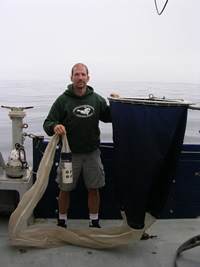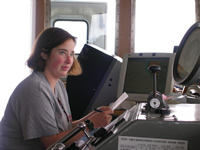


|
The Project
|
August 27, 2005
A Career at Sea and Calculating Distance The night was clear, with a cold breeze, the science team on the New Horizon worked through the long nighttime hours. The team of six split the shift, some sleeping while others worked. When morning came, the breakfast meal was attended by those that were ready for bed and others who had just awakened for the day. Thin layers of plankton were observed during the night. The ship traveled slowly in an arc back and forth over the monitoring station. Early after dark the echo sounder observed the distinctive thin layer pattern that we were looking for. Water samples were collected from the thin layer areas. Also, during the night, several plankton tows were made with a large net (see photo). This net collected a sample of zooplankton during each tow. The sample was preserved and later will be analyzed by a marine plankton specialist. After breakfast the ship was prepared for a 5 hour run to the outside of the Monterey Bay Marine Sanctuary. The ship’s officers kept the ship straight on a westward course with a 279-degree compass reading. The New Horizon has one captain, a first mate and a third mate who are trained and licensed to command vessels this size. A third mate has graduated from a maritime academy and they have taken and passed their third mate exam. After a third mate spends 365 days at sea they are allowed to sit for their second mate exam. Being first mate requires 365 more days at sea and other exam. The chief or captain spends another 365 days at sea and yes, another exam. It normally takes two years to get the 365 days required for each advancement in position. Math: What is the minimum number of days that a captain or chief mate spent at sea? How many years will it take for a third mate to become a captain? Melissa Turner is the third mate on this research expedition. She takes over the bridge (control center) on 4-hour shifts. She sleeps during the hours between shifts. Melissa grew up in the state of Massachusetts on the East coast. While in high school she wanted to join and train with the Coast Guard but she did not meet the qualifications because of her nearsightessness. This set back did not stop her from reaching her goal of going to sea. She entered the Massachusetts Maritime Academy and graduated with a third mate license in the year 2000. She has now worked in her current position with Scripps Institution of Oceanography for four and one half (4 ½) years. She is currently planning for vacation time in November. Her home is still in Boston and this is where she goes when she is not aboard a ship. She likes being out with the bigger research vessels because they travel further from port. She has been to many seaports and in many oceans but her favorite place, so far, is in the South Seas near New Zealand. Melissa uses simple math everyday during her duties at sea. She can easily add and subtract latitudes and longitudes in order to calculate distance traveled. Using a globe or a world map find the lines of longitude and the lines of latitude. Lines of longitude run from the North Pole down to the South Pole. Lines of latitude run horizontally, equal distance apart, across the globe. Our current position on the globe or map is latitude 36° 56.722’ N. This means we are more than 36 degrees north of the Equator. Our longitude position is 122° 29.202’ W, which means we are more than 122 degrees west of the Greenwich (England) meridian. As we head east back to the sanctuary our longitude is changing constantly. Our longitude when we get back to station is 122°00.208’. Our distance traveled can be calculated by subtraction. Math: When locations are name by their distance from a fixed line or point, distance traveled can be calculated by finding difference between two numbered locations. Try calculating the distance traveled across a state on an interstate highway where the distance from one end of the state is indicated by the exit number. If you start traveling at exit 46 and end at exit 304, how far have you traveled?
|


